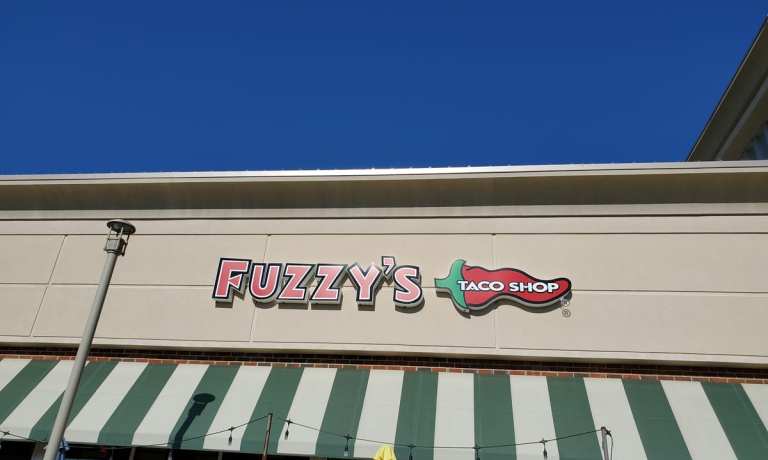
The pandemic has left consumers with two nearly opposite sets of expectations when it comes to restaurant ordering. On the one hand, extended amounts of time separated from their friends and families has left many consumers seeking out immersive, connective experiences, coming together over a good meal. On the other hand, the rise in digital ordering has left many consumers looking for increasingly quick and convenient ways to meet their food needs. Accordingly, many previously dining room-centric restaurants are debuting new off-premises ordering options, just as a handful previously delivery-only restaurants are establishing physical spaces to build deeper relationship with their customers.
For rapidly expanding fast-casual chain Fuzzy’s Taco Shop, the answer was to deliver a dual solution that offers both budget-friendly off-premise options as well as more social on-premise experiences.
“What stands out for us is that we’re a fast-casual player with a full bar, which is pretty unique in the space, and everything is done with value for our guests in mind,” Jessica Wescott, Fuzzy’s chief operating officer and chief financial officer, told PYMNTS in an interview. “So the goal for us is to appeal to families at stores that may want to be able to get in and out at a very low cost, and then also to [appeal to] a group … that may want to go out for happy hour with their girlfriends and not break the bank.”
To that point, all of the brand’s 140 stores have patios, which creates an experience very different from the traditional short-visit experience of fast-casual dining. This two-pronged approach may be key in months ahead. PYMNTS research from the May edition of our Delivering on Restaurant Rewards report, created in collaboration with Paytronix, finds that more than a quarter of consumers’ primary pandemic-related concerns pertain to their health, while more than 1 in 5 consumers report primary concerns pertain to their social lives. These findings suggest that there is a huge amount of demand both for low-cost meal options and for inviting hang-out spots.
Fork In The Road
Speaking to this bifurcation in the fast-casual category, Wescott noted, “I think you’re starting to see this divide in the fast casual segment … [There are] the brands that you will likely [order] pick up more, going forward, and then the brands that you’re looking forward to coming back to and sitting down at.”
Her prediction mirrors that of Doron Friedman, co-founder and chief product officer of restaurant management system and point of sale (POS) provider SpotOn, who told PYMNTS in an interview earlier this month that there will be “two extremes” in restaurants’ future. He predicted that off-premises-focused restaurants will become increasingly hands-off, with automation driving speed and efficiency, while full-service restaurants will “lean into a much more social experience.”
For this latter category, Wescott predicts that brands looking to create that attractive on-premises experience will debut larger store models, appealing to consumers’ sense of restlessness and hunger for novelty and meeting their need “to escape the four walls of their house.”
Growing … Growing … Grown
Earlier this month, Fuzzy’s announced its expansion into Wyoming, its eighteenth U.S. state, with plans, through the same franchise deal, to open its first stores in Montana. In addition to adding new locations, the company is also building out its ordering options.
“The pandemic gave us a really unique opportunity to gain a lot of traction with our guests and to further those [online ordering] programs beyond what they had been doing pre-pandemic, now that the guests really want the digital experience,” Wescott said.
In July, she said, Fuzzy’s will go into phase two of testing its super fan club, a higher tier of loyalty rewards that comes with exclusive offers and points-earning opportunities. In Q4, the company will also launch online catering ordering.
“We’ve got this … very forward-facing, positive outlook on what COVID has brought to the table as far as opportunities, instead of allowing ourselves, as would been fairly easy throughout the pandemic, to feel defeated,” Wescott reflected.
Broad Appeal: A Double-Edged Sword
“Typical brands are able to see a high concentration in maybe one to three types of demographic or sociographic categories,” explained Wescott. “For Fuzzy’s, we really don’t have a strong concentration in any one of those.”
With its off-premises channels, its full-service bar and its fairly expansive and flexible menu, Fuzzy’s attracts customers from a wide variety of walks of life. In any given restaurant, Wescott said, “You’re going to see young people in their mid-20s, you’re going to see older people who appear to be retired, you’re going to see businessmen in suits and ties, and you’re going to see people dressed very casually.” This broad appeal, she said, is “really fun for development and a little bit more challenging when it comes to targeting customers from a marketing perspective.”
After all, segmentation can be an essential tool for growing brands to stay in touch with the desires of their customers, and the broader a base a restaurant serves, the more difficult it is to predict that base’s behaviors. Still, Wescott noted that the brand has a “cult-like following” of customers that often recommend the restaurant to others in their social network, organically generating brand awareness.
The combination of this loyal following and, of course, the in-restaurant bars are helping Fuzzy’s navigate the way into its post-COVID future.
“We’re actually seeing, maybe surprisingly or not so surprisingly, a lot more in the alcohol sales piece of it,” said Wescott. “So people are coming to hanging out longer in our restaurant than they were pre-pandemic, they’re bringing more people … and then they’re … adding a few extra margs that maybe before they weren’t.”